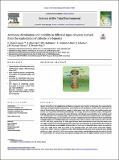Por favor, use este identificador para citar o enlazar a este item:
http://hdl.handle.net/10261/263092COMPARTIR / EXPORTAR:
 SHARE SHARE
 CORE
BASE CORE
BASE
|
|
| Visualizar otros formatos: MARC | Dublin Core | RDF | ORE | MODS | METS | DIDL | DATACITE | |

| Título: | Antimony distribution and mobility in different types of waste derived from the exploitation of stibnite ore deposits |
Autor: | Álvarez Ayuso, Esther CSIC ORCID ; Murciego, Ascensión; Rodríguez González, M. Ángeles; Fernández Pozo, Luis; Cabezas, José; Naranjo Gómez, José Manuel; Mosser Ruck, Régine | Palabras clave: | Chemical fractionation Mine wastes Mobilization Toxic metalloids Weathering products |
Fecha de publicación: | 2022 | Editor: | Elsevier | Citación: | Science of the Total Environment 816: 151566 (2022) | Resumen: | Wastes derived from the exploitation of stibnite ore deposits were studied to determine their mineralogical, chemical, and environmental characteristics and establish the Sb distribution and the current and long-term risks of Sb mobilization. Representative samples of mine waste rocks, mine tailings, and smelting waste were studied by X-ray powder diffraction, polarized light microscopy, electron microprobe analysis, and digestion, leaching, and extraction procedures. The main Sb-bearing minerals and phases identified in the smelting waste were natrojarosite, iron (oxyhydr)oxides, mixtures of iron and antimony (oxyhydr)oxides, and tripuhyite; those in the mine tailings and mine waste rocks were iron (oxyhydr)oxides and/or mixtures of iron and antimony (oxyhydr)oxides. Iron (oxyhydr)oxides and natrojarosite had high Sb contents, with maximum values of 16.51 and 9.63 wt% Sb2O5, respectively. All three types of waste were characterized as toxic; the mine waste rocks and mine tailings would require pretreatment to decrease their leachable Sb content before they would be acceptable at hazardous waste landfills. Relatively little of the Sb was in desorbable forms, which accounted for <0.01 and <0.8% of the total Sb content in the smelting waste and mine waste rocks/mine tailings, respectively. Under reducing conditions, further Sb mobilization from mine waste rocks and mine tailings could occur (up to 4.6 and 3.3% of the total content, respectively), considerably increasing the risk that Sb will be introduced into the surroundings. Although the smelting waste had the highest total Sb content, it showed the lowest risk of Sb release under different environmental conditions. The significant Fe levels in the smelting waste facilitated the formation of various Fe compounds that greatly decreased the Sb mobilization from these wastes. | Descripción: | 14 páginas, 3 tablas, 6 figuras | Versión del editor: | http://dx.doi.org/10.1016/j.scitotenv.2021.151566 | URI: | http://hdl.handle.net/10261/263092 | DOI: | 10.1016/j.scitotenv.2021.151566 | ISSN: | 0048-9697 | E-ISSN: | 1879-1026 |
| Aparece en las colecciones: | (IRNASA) Artículos |
Ficheros en este ítem:
| Fichero | Descripción | Tamaño | Formato | |
|---|---|---|---|---|
| Antimony distribution and mobility in different types of waste derived from the exploitation of stibnite ore deposits.pdf | Artículo principal | 3,63 MB | Adobe PDF |  Visualizar/Abrir |
CORE Recommender
SCOPUSTM
Citations
8
checked on 19-abr-2024
WEB OF SCIENCETM
Citations
7
checked on 27-feb-2024
Page view(s)
43
checked on 24-abr-2024
Download(s)
147
checked on 24-abr-2024
Google ScholarTM
Check
Altmetric
Altmetric
Este item está licenciado bajo una Licencia Creative Commons

